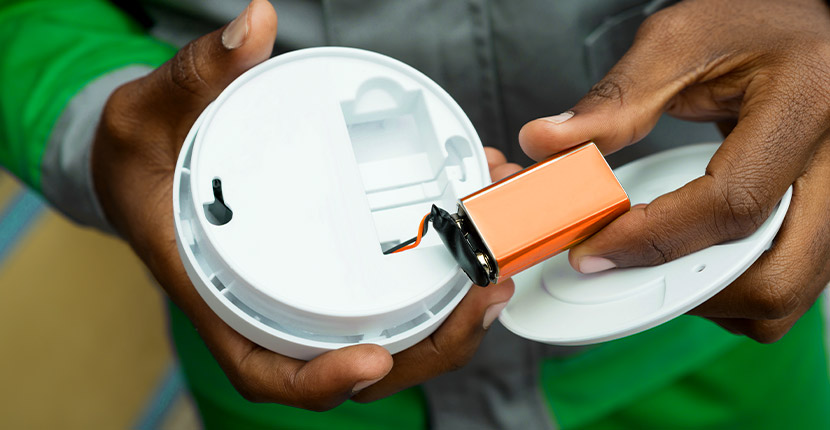How to Change the Batteries in Your Smoke or Carbon Monoxide Detector
- by Bryan Veldboom - updated on 11/3/2021

The end of Daylight Savings Time is just around the corner. Since you're already going to be setting back your clocks, it's also a great time to test the batteries in your smoke and carbon monoxide detectors. Learn about the different types of smoke and carbon monoxide detectors available, along with suggestions on how to maintain them.
What are the Different Types of Smoke and Carbon Monoxide Detectors?
There are three separate types of smoke and carbon monoxide detectors:
- Battery-Operated - These devices run entirely on disposable batteries, which can be swapped out when they run out of power.
- 10-year Detectors - This type of smoke and carbon monoxide detector comes sealed with a non-removable lithium battery that is guaranteed to last for 10 full years. After that, the whole device needs to be replaced. There is a growing trend toward sealed detectors, with a number of states requiring them instead of battery-operated models.
- Hardwired - A hardwired detector is a device that is directly wired into your home's electrical system. They run on electricity, but have a backup battery that allows them to continue operating during a power outage.
How Do I Test a Smoke Detector's Batteries?
It is recommended that you test your smoke detectors every month. The device itself features a test button that will briefly sound the alarm when pushed. If the alarm doesn't sound or it doesn't seem loud enough, you should replace the batteries and test it again. If you still don't hear anything, your smoke detector is most likely faulty and the entire unit will need to be replaced. For 10-year or hardwired systems, if they refuse to work, the entire device will need to be replaced.
How Do I Test a Carbon Monoxide Detector's Batteries?
The process of testing a carbon monoxide detector is very similar to how you test a smoke detector and should also be done once a month. Locate the test button and hold it down. Depending on the model you have, your carbon monoxide detector will either beep several times or sound its alarm for several seconds. If the alarm doesn't go off or sounds too quiet, you should replace the batteries and test it again. If you have a sealed or hardwired model that no longer works, you'll need to pick up a replacement unit as soon as possible.
One thing to keep in mind is that the method above only tests whether the device's battery and circuitry are working. To test the detector's CO sensor you will need to pick up a CO detector test spray and follow the instructions on the packaging.
How Do I Stop My Smoke Detector from Chirping?
If you hear a beeping or chirping sound coming from your smoke or carbon monoxide detector it means that the battery is running low. Swapping it out with a new battery should solve the problem. If you don't have any replacement batteries on hand, be sure to pick some up before removing the current battery, so that you don't forget to replace it. For 10-year systems, a chirping sound means it's time to get a replacement unit.
How Long Do Smoke and Carbon Monoxide Detectors Last?
Experts recommend replacing your smoke detectors every 10 years and your carbon monoxide detectors every 7 years. An easy way to determine the replacement date is to locate the manufacture date on the back of the device and add 10 years (7 in the case of carbon monoxide detectors) to that date.
What Type of Batteries Do Smoke and Carbon Monoxide Detectors Use?
Most smoke and carbon monoxide detectors run on 9-volt batteries, although there are some models that require AA or AAA batteries. Batteries Plus has the alkaline batteries you need from top brands like Rayovac® and Duracell® that are guaranteed to last years in storage. We also offer alkaline battery testers and storage boxes to help keep them in good working condition.
How Do I Replace the Batteries in a Smoke or Carbon Monoxide Detector?
Replacing the batteries in your home alarm systems is easy. Just follow these simple steps. Please note, if you own a hardwired smoke or carbon monoxide detector, you need to turn off the main power at your circuit breaker before working on it. Regardless of the type of smoke or carbon monoxide detector you have, it's recommended that you replace the batteries at least once a year.
Step #1 Remove the Device's Cover
The majority of smoke and carbon monoxide detectors will feature a twist-open cover. Other models will need to be popped off by hand or may feature a plastic lock that you'll have to open using a screwdriver. The user's manual or manufacturer's website will provide you with the correct method for removing the cover.
Step #2 Swap the Battery
Remove the old battery and replace it with a new one, making sure to line up the positive and negative connections with the labels on the device. Be sure that your replacement battery is compatible with your specific model device. For instance, if your smoke detector runs on 9-volt batteries, don't try using a different size.
Do I Need an Electrician to Replace Hardwired Smoke Detectors?
When dealing with hardwired devices, certain basic tasks such as testing and replacing the battery can be completed on your own. However, installing a hardwired smoke or carbon monoxide detector should always be completed by a knowledgeable professional.
Visit Batteries Plus for Batteries, Replacement Detectors and More
Shop our selection of battery-operated, sealed 10-year and hardwired smoke and carbon monoxide detectors either online or in-store.